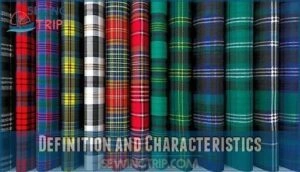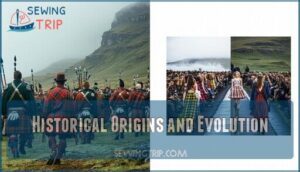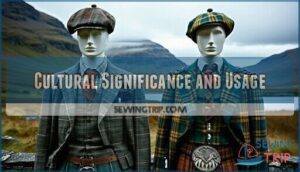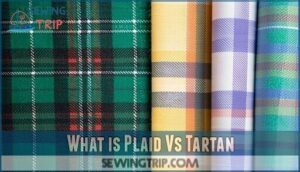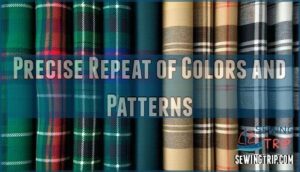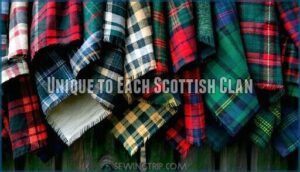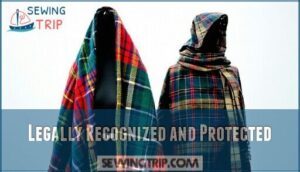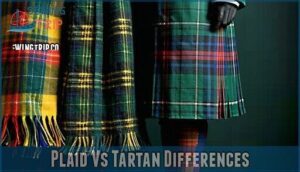This site is supported by our readers. We may earn a commission, at no cost to you, if you purchase through links.
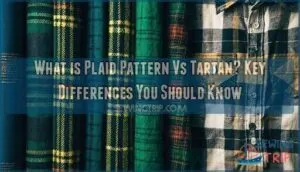
Tartan is a specific pattern historically tied to Scottish clans, with each design officially registered and carrying deep cultural significance. Think of tartan as a family crest woven into fabric.
Plaid, on the other hand, is a broader term. It refers to any checkered or crisscrossing design, used casually in fashion and home decor.
Tartan demands precision in its repeated patterns and colors, while plaid is more a free spirit, open to interpretation. Curious about tartan’s legal protections or plaids’ global rise? Keep that thought handy!
Table Of Contents
Key Takeaways
- Tartan is tied to Scottish heritage, featuring precise, symmetrical patterns unique to clans, while plaid is a broader term for any crisscross or checkered design.
- All tartans are plaids, but not all plaids qualify as tartans due to the cultural and historical significance tied to tartans.
- Plaid patterns are versatile and widely used globally in casual fashion and home decor, while tartans are reserved for formal events and clan symbolism.
- You can design a custom tartan to represent a group or story, and it can be registered with the Scottish Register of Tartans.
Plaid Pattern Basics
Plaid refers to a crisscross pattern of two or more colors, often seen in fabrics like shirts or blankets.
It’s a versatile design with no strict rules, making it popular in casual fashion and home decor.
Definition and Characteristics
Plaid patterns feature crisscrossing lines in two or more colors, offering flexible design elements and weaving techniques.
Tartan patterns, however, are precise, repeating setts tied to Scottish heritage. While plaid characteristics emphasize versatility in fabric composition and color usage, tartan characteristics reflect cultural significance.
Understanding plaid vs tartan lies in recognizing their distinct patterns, histories, and purposes in design.
Historical Origins and Evolution
The plaid pattern’s roots trace back to Gaelic blanket origins, evolving into Highland clan garments for practicality.
Rooted in Gaelic traditions, plaid evolved from humble blankets into an iconic blend of practicality and timeless style.
The Dress Act of 1746 banned tartan patterns, suppressing Scottish heritage.
Later, 18th-century fashion revived tartans, intertwining them with Scotland’s cultural identity and history.
Cultural Significance and Usage
The plaid pattern thrives in casual fashion, embraced globally for its versatility.
Unlike Scottish tartan, deeply tied to clan heritage and formal events, plaid lacks cultural restrictions.
Scottish tartan symbolizes Scottish heritage, often worn during weddings or Highland games.
Meanwhile, plaid’s global adoption highlights its commercialization, making it a staple in everyday wear without ties to Scottish culture.
When sewing plaid, consider how raglan seams complicate matching.
What is Plaid Vs Tartan
Understanding the difference between plaid and tartan can feel like untangling threads in a loom.
While both share crisscross patterns, their origins and meanings set them apart.
Tartan is a specific type of plaid pattern tied to Scottish clans, featuring a precise, repeatable design called a "sett."
It’s deeply rooted in history, symbolizing heritage and identity.
Plaid, on the other hand, is more of a free spirit.
It refers to any checkered or striped pattern, often without cultural ties or strict rules.
Here’s a quick comparison:
| Feature | Tartan | Plaid |
|---|---|---|
| Origin | Scottish heritage | Global perceptions |
| Cultural Significance | Clan identity | Casual fashion |
| Pattern Structure | Precise, symmetrical | Flexible, asymmetrical options |
| Weaving Techniques | Traditional looms | Modern interpretations |
| Design Evolution | Historical roots | Trend-driven patterns |
Both patterns connect history and design in unique ways, making them interesting to explore and understand.
Tartan Pattern Features
Tartan patterns are carefully structured with a precise, repeating arrangement of colors and lines, creating a symmetrical design known as a "sett.
Each tartan is unique to a Scottish clan, legally recognized, and holds deep historical and cultural significance, making tartan a key part of their identity.
Precise Repeat of Colors and Patterns
A tartan pattern stands out with its precise sett composition, where thread counts and weaving symmetry create a consistent, repeatable design.
Each tartan’s colors and widths align perfectly, making pattern identification straightforward.
Unlike a plaid pattern, tartans follow strict rules, often tied to pattern registration, highlighting key pattern differences in their cultural and technical roots.
Unique to Each Scottish Clan
Each Scottish clan boasts its own tartan, symbolizing identity and heritage.
A tartan embodies Scottish clan identity, weaving history, pride, and heritage into every thread.
These patterns often reflect the natural hues of their region and are passed down through generations.
One way to achieve unique textures in fabric is through different weave patterns.
Here’s what makes tartans unique:
- Clan Tartan History: Each design ties to specific clans.
- Regional Variations: Colors mirror local landscapes.
- Tartan Symbolism: Represents pride and unity.
- Clan Recognition: Patterns identified territories.
Legally Recognized and Protected
Tartan patterns carry unique identity but aren’t guarded by strong legal protections.
Registered with the Scottish Register of Tartans, a design’s origin and details are documented, not enforced.
Some clan tartans, though, may have certain copyrights, hinting at ownership.
Here’s a quick breakdown:
| Feature | Description |
|---|---|
| Registration | Scottish Register of Tartans records designs. |
| Enforcement | Registration doesn’t prevent copying. |
| Copyright | Exists for some commercial or new tartans. |
| Cultural Weight | Symbolizes heritage, not legality. |
| Counterfeit Laws | Limited or non-existent protection in practice. |
Plaid Vs Tartan Differences
You might think plaid and tartan are interchangeable, but they’re not.
Tartan is a culturally significant pattern tied to Scottish heritage, while plaid refers to a broader range of crisscross patterns without the same historical ties, making tartan a unique aspect of Scottish culture.
Pattern Characteristics and Design
Tartan patterns stick to precise sett patterns, creating visually striking symmetry, while plaid fabrics allow for freer textile design.
The tartan pattern’s weaving techniques guarantee consistent repeats of color, often tied to meaningful color symbolism. Plaid’s crisscross pattern offers more flexibility.
Weave structure determines the overall drape and breathability of the fabric.
Here’s a closer look at the differences between tartan and plaid:
| Feature | Tartan | Plaid |
|---|---|---|
| Sett Patterns | Precise and structured | Varied, flexible |
| Symmetry | Always symmetrical | Symmetry optional |
| Weaving Techniques | Traditional looms | Modern approaches |
| Color Symbolism | Cultural significance | Often aesthetic |
| Modern Dyes | Preserves tradition | Bold experimentation |
The key differences between tartan and plaid lie in their sett patterns, symmetry, and weaving techniques, which affect the overall appearance and cultural significance of the fabrics.
Cultural and Historical Significance
How did tartan become iconic? Deeply tied to Scottish clans, tartan symbolizes identity and heritage.
Each pattern reflects a clan’s history, blending art and storytelling. Plaid, often seen in fashion, carries less historical weight but evolved globally for its versatility.
Explore tartan’s cultural roots versus plaid’s modern flair.
| Aspect | Tartan | Plaid |
|---|---|---|
| Origin | Scottish culture, tied to clans | Broader, informal origins |
| Cultural Ties | Deep heritage symbolism | Minimal |
| Pattern Rules | Strict, clan-specific | Flexible |
| Historical Use | Ceremonial and symbolic | Everyday wear |
| Global Impact | Scottish heritage essential | Evolved into versatile fashion piece |
Usage and Adoption
When comparing tartan and plaid, their usage and adoption vary widely.
Tartan often shines in formal events, embodying Scottish culture and heritage, while plaid thrives in casual fashion trends and home decor.
Modern adaptations make both patterns global markets’ staples.
However, tartan’s design influence ties deeply to identity, while plaid freely blends into diverse styles.
| Aspect | Tartan | Plaid |
|---|---|---|
| Cultural Significance | Strong ties to Scottish culture | Broad, lacks specific ties |
| Primary Usage | Formal events and ceremonies | Everyday fashion and decor |
| Design Rule | Precise, clan-specific | Loose, versatile |
| Global Appeal | Heritage emphasis | Adaptable, modern trends |
Tartan and Plaid Usage
You’ll see tartan used in formal events like weddings or Highland games, symbolizing Scottish heritage and clan pride.
Plaid, on the other hand, thrives in casual fashion and everyday items, celebrated globally for its versatility.
Formal Events and Ceremonies
For formal occasions like Highland Gatherings, Scottish Weddings, and Clan Celebrations, tartan embodies heritage symbolism and connection to Scottish clans.
It often appears as kilts or sashes, forming iconic Highland attire.
Plaid, though less tied to heritage, can complement formal attire, adding a stylish touch.
Tartan honors Scottish heritage, while plaid embraces versatility in formal events.
Many choose to wear tartan kilts formally at these events, showcasing Scottish heritage.
Casual Fashion and Everyday Use
Plaid’s popularity in casual fashion is undeniable, blending everyday versatility with timeless charm.
Modern adaptations of plaid, tartan, and check patterns inspire fashion trends worldwide.
From comfy flannel shirts to chic scarves, plaid perfectly pairs style and function, offering endless options for casual wear.
Its design inspiration lies in its adaptability, connecting subtly to tartan’s historical richness, and understanding the importance of seasonal fabric choices is key to maximizing comfort.
Global Adoption and Commercialization
Tartan and plaid have taken the fashion industry by storm, blending cultural significance with mass production.
Across global markets, these iconic fabrics adapt beautifully.
Here’s how they shine:
- Tartan patterns elevate modern haute couture.
- Plaid dominates casual wear globally.
- Design variations thrive in home décor.
- Brands embrace custom tartan for identity.
- Festivals celebrate their timeless appeal.
The industry has seen extensive product offerings.
Frequently Asked Questions (FAQs)
Are tartan and plaid the same thing?
Ever wonder why some patterns feel more personal?
Tartan reflects specific Scottish clans, with historical significance and set weaving rules.
Plaid, though simpler, is any crisscross design, often stylish but without cultural ties.
Why do Americans say plaid and not tartan?
Americans say "plaid" instead of "tartan" because the term evolved to describe any crisscross pattern in fabrics.
Tartan’s specific cultural ties to Scottish clans aren’t as commonly recognized in the U.S., simplifying its terminology to just "tartan".
Is Burberry plaid or tartan?
Burberry’s iconic pattern is a plaid, not a tartan.
It features a crisscross design without ties to Scottish clans.
Known as the "Burberry Check," it’s more fashion statement than cultural heritage.
What is considered plaid pattern?
Picture a cozy flannel shirt: a plaid pattern shows crisscrossing horizontal and vertical lines in different colors.
It’s versatile, not tied to traditions, and ranges from simple checks to intricate, irregular designs that feel timeless.
What is the difference between plaid and tartan?
Tartan belongs to Scottish heritage, representing clans with consistent, symmetrical patterns.
Plaid covers any crisscross design, lacking tartan’s cultural ties.
All tartans are plaid, but not all plaids qualify as tartan.
What colors are traditionally used in tartan fabrics?
Tartan fabrics traditionally use bold, earthy tones like deep greens, rich reds, and dark blues, often accented by black, white, or yellow.
These colors symbolized clans, regions, and even social status in Scottish heritage.
Is it possible to design a custom tartan?
Yes, you can design a custom tartan.
It involves choosing specific colors and patterns that represent your group, family, or story.
Once created, you can register it with the Scottish Register of Tartans for authenticity.
How long has the plaid garment been a part of Highland Dress?
Plaid garments have been part of Highland dress since at least the 16th century.
Originally, Highlanders used large woolen plaids as versatile garments, offering warmth, practicality, and a connection to Scotland’s rugged landscape.
Does tartan have any specific meaning or symbolism associated with it?
Tartan isn’t just fabric; it’s like a family crest woven into cloth.
Each pattern, or "sett," represents a Scottish clan, history, or region, symbolizing identity, heritage, or even religious connections through its colors and design.
How do tartans relate to Scottish geography?
Tartans are closely tied to Scotland’s geography, with many patterns representing specific regions, towns, or landscapes.
They reflect local heritage, often incorporating colors inspired by nature, like greens for forests or blues for lochs, which represent the landscapes.
Conclusion
Much like the distinction between a fingerprint and a general design, tartan and plaid each hold unique identities.
While tartans are rooted in Scottish heritage, carefully registered patterns tied to clans, plaid refers broadly to checkered designs without strict rules.
Understanding "what is plaid pattern vs tartan" helps highlight their cultural roles—plaid’s global versatility and tartan’s historical pride.
So, next time you spot these patterns, you’ll see their deeper meaning woven into every thread.

